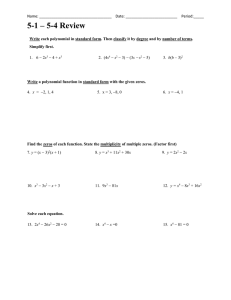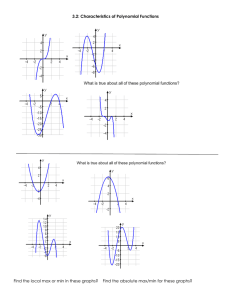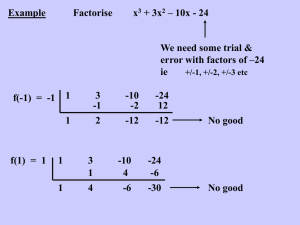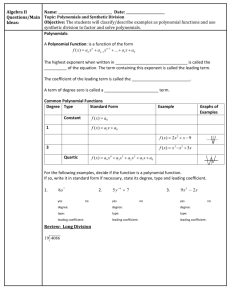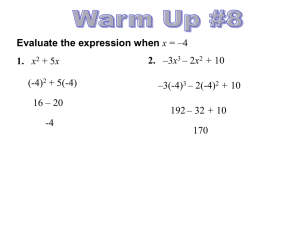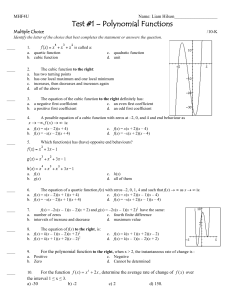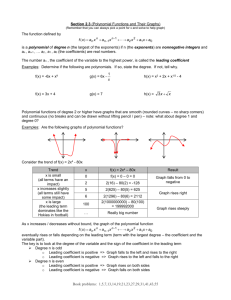Algebra II Name: Unit #3 Test Review Block: ______ For problems 1
advertisement
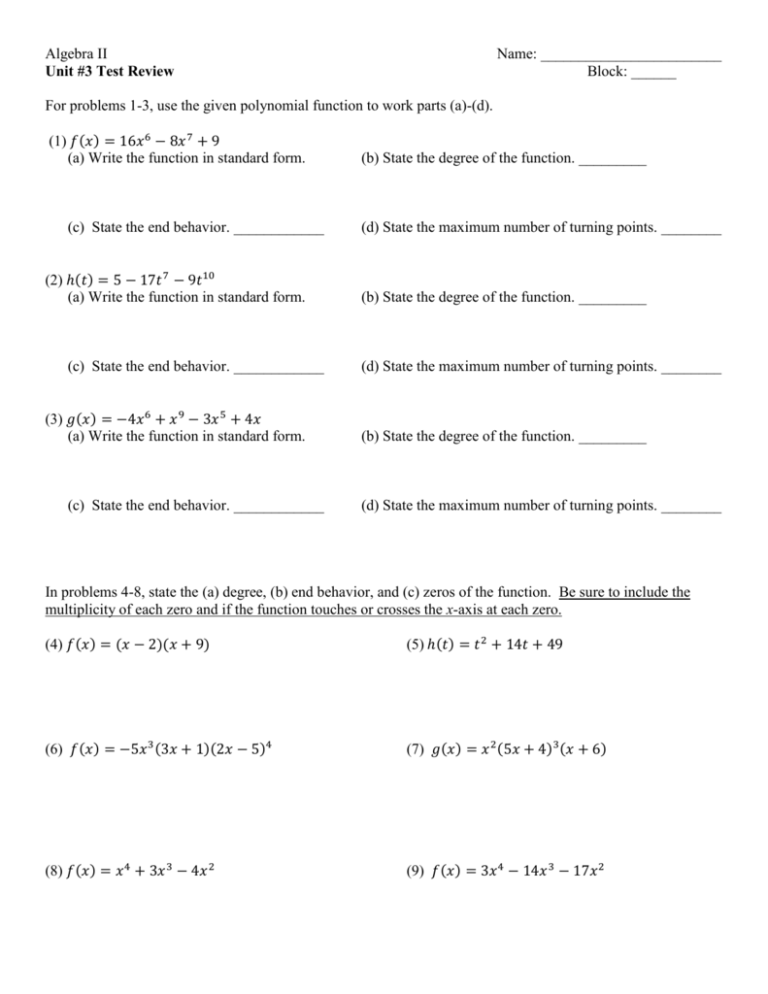
Algebra II Unit #3 Test Review Name: ________________________ Block: ______ For problems 1-3, use the given polynomial function to work parts (a)-(d). (1) 𝑓(𝑥) = 16𝑥 6 − 8𝑥 7 + 9 (a) Write the function in standard form. (c) State the end behavior. ____________ (2) ℎ(𝑡) = 5 − 17𝑡 7 − 9𝑡10 (a) Write the function in standard form. (c) State the end behavior. ____________ (3) 𝑔(𝑥) = −4𝑥 6 + 𝑥 9 − 3𝑥 5 + 4𝑥 (a) Write the function in standard form. (c) State the end behavior. ____________ (b) State the degree of the function. _________ (d) State the maximum number of turning points. ________ (b) State the degree of the function. _________ (d) State the maximum number of turning points. ________ (b) State the degree of the function. _________ (d) State the maximum number of turning points. ________ In problems 4-8, state the (a) degree, (b) end behavior, and (c) zeros of the function. Be sure to include the multiplicity of each zero and if the function touches or crosses the x-axis at each zero. (4) 𝑓(𝑥) = (𝑥 − 2)(𝑥 + 9) (5) ℎ(𝑡) = 𝑡 2 + 14𝑡 + 49 (6) 𝑓(𝑥) = −5𝑥 3 (3𝑥 + 1)(2𝑥 − 5)4 (7) 𝑔(𝑥) = 𝑥 2 (5𝑥 + 4)3 (𝑥 + 6) (8) 𝑓(𝑥) = 𝑥 4 + 3𝑥 3 − 4𝑥 2 (9) 𝑓(𝑥) = 3𝑥 4 − 14𝑥 3 − 17𝑥 2 For problem #10, write an equation for a polynomial function of least degree in factored form, with the given zero values. (a) 𝑥 = 4, −1, and 0 (𝑚𝑢𝑙𝑡𝑖𝑝𝑙𝑖𝑐𝑖𝑡𝑦 𝑜𝑓 2) lead coefficient is -3 (b) 𝑥 = −3 (𝑚𝑢𝑙𝑡𝑖𝑝𝑙𝑖𝑐𝑖𝑡𝑦 𝑜𝑓 3), 1, 5 lead coefficient is 2 (11) Write an equation for a polynomial function in STANDARD form with the given zero values: 𝑥 = −8, −2, 𝑎𝑛𝑑 0. Show your work! For problem #12 determine the sign of the leading coefficient (positive vs. negative) and whether the degree of the function is even or odd from the graph. Explain how you know. (a) (b) For #13 sketch a graph of a function with the following features: (a) positive lead coefficient, even degree, (b) negative lead coefficient, even degree, and two zeros that both have a multiplicity of 2. and five turning points. (14) Simplify the following functions into standard form. Then classify them by their degree and number of terms (2 names). Show all steps of your work. (a) 𝑓(𝑥) = 5𝑥 2 (−6𝑥 3 − 12𝑥) (b) 𝑓(𝑥) = −3𝑥 3 (8𝑥) (c) 17 − 8𝑥 3 − 12𝑥 3 + 1 (15) FACTOR the polynomials. Show your work! Look for GCF First, Think “SOAP” (a) 𝑓(𝑥) = 𝑥 3 – 125 (b) 𝑓(𝑥) = 16𝑥 3 + 54 (c) 𝑓(𝑥) = −8𝑥 3 – 1000 (16) SOLVE the polynomials by factoring. Show your work! (a) x3 – 3x2 – 16x + 48 = 0 (b) 2x3 – 3x2 +10x -15 = 0 (17) Use synthetic substitution to evaluate the function and find P(a). Show your work! (a) P(x) = 5x3 12x2 + 2x + 1, a = 6 (b) P(x) = 2x3 + 3x 6, a = 1 (18) Using Synthetic Substitution, determine whether the given value is a ZERO of the function (a) f(x) = x3 + 5x 15; x = 1 (b) f(x) = 2x4 + 7x3 11x2 + 21x + 5; x = -1 Zero / Not a Zero Zero / Not a Zero (19) Using Synthetic Substitution, determine whether the binomial is a FACTOR of the function. (a) f(x) = 2x3 + 9x2 + 13x + 6; (x + 1) (b) f(x) = x3 + x2 14x 27; (x + 3) Factor / Not a Factor Factor / Not a Factor For problem #20 use the function𝒇(𝒙) = 𝒙𝟒 + 𝟒𝒙𝟑 − 𝟓𝒙𝟐 . (a) Using the function above state the (a) degree, (b) end behavior, and (c) zeros of the function. Be sure to include the multiplicity of each zero and if the function touches or crosses the x-axis at each zero. Use this information to sketch the graph of the function. Hint: FACTOR FIRST!! (b) Use your calculator to find the turning points of the graph. Be sure to state if the point is a relative/local maximum or minimum value. State the intervals of the x-values on which the graph is increasing and the intervals on which it is decreasing. (reminder: write inequalities of x, look at positive slope vs. negative slope) Increasing: Decreasing:
